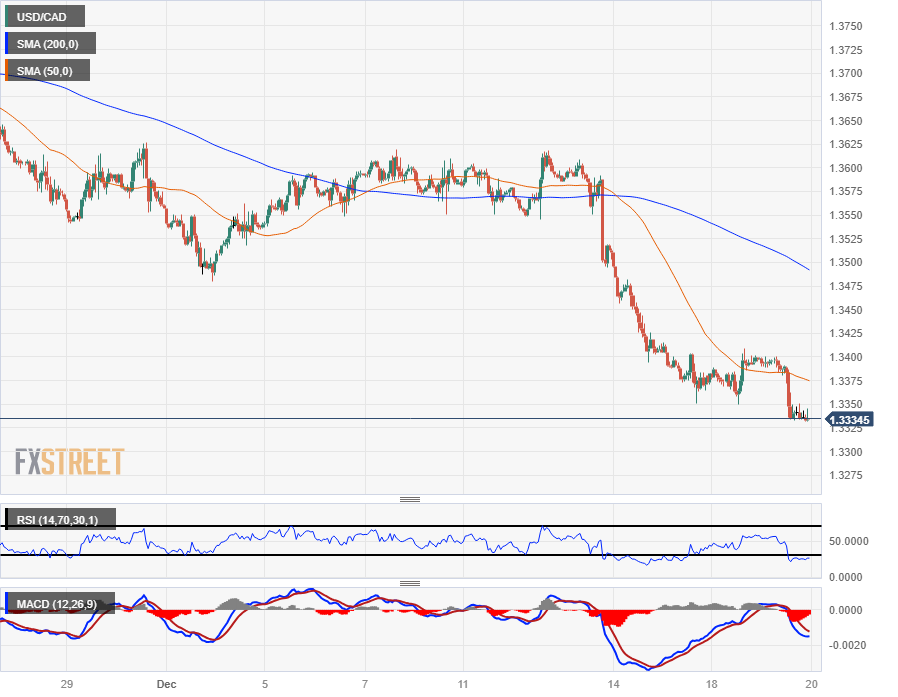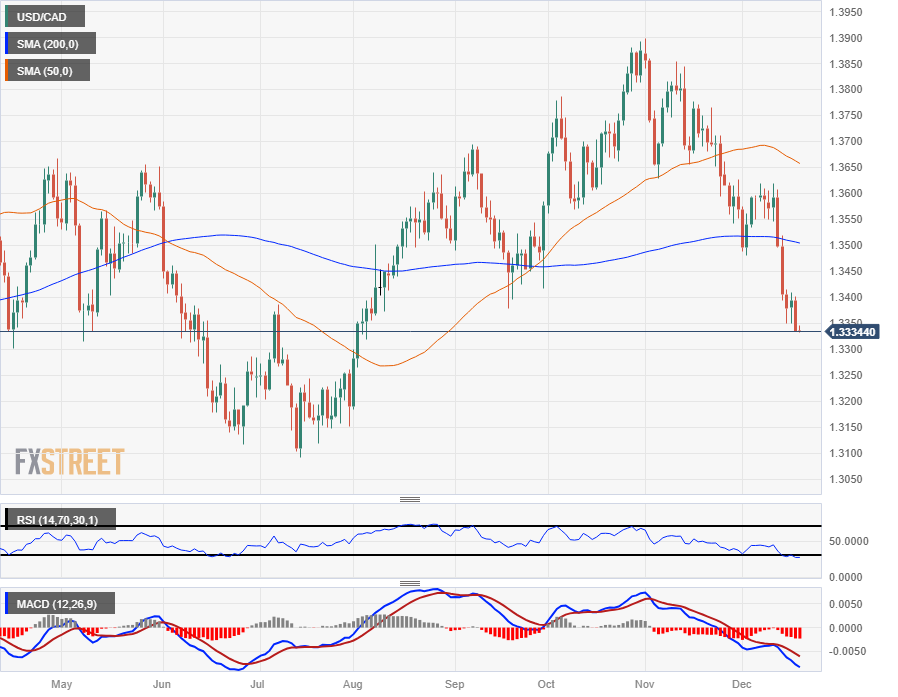Canadian Dollar ekes out small gain on the US Dollar after Canadian CPI inflation beat
- The CAD caught a Tuesday jolt after Canadian CPI inflation came in above expectations.
- Economic calendar data sees limited impact as markets gear up for holidays.
- Canadian Retail Sales & GDP to round out the trading week.
The Canadian Dollar (CAD) caught a limited but decisive bid on Tuesday following a better-than-expected Canadian Consumer Price Index (CPI) inflation print, dragging the CAD into the green against the US Dollar (USD), but limited data impact sees the CAD still down against the majority of major currency peers for the day.
CPI inflation in Canada printed at 3.1% for the year through November, beating expectations and giving the Canadian Dollar a slight boost. The rest of the week sees a steady trickle of Canadian data heading into the holiday shutdown, with the Bank of Canada’s (BoC) latest Summary of Opinions on Wednesday, followed by Canadian Retail Sales for October on Thursday, and the week rounds out with the final Canadian Gross Domestic Product (GDP) print for 2023.
Daily Digest Market Movers: Canadian Dollar mixed on the day, but catching some lift against the Greenback
- The Canadian Dollar is up around half of a percent against the US Dollar on Tuesday, and up over a full percent against the Japanese Yen (JPY).
- The Loonie is losing noticeable ground against the Antipodeans, down nearly half a percent against both the Australian Dollar (AUD) and the New Zealand Dollar (NZD).
- Canada’s Consumer Price Index (CPI) came in at 3.1% for the year through November, holding steady with the previous print and beating the forecast decline to 2.9%.
- MoM CPI for November also beat expectations, holding steady at 0.1% versus the forecast -0.2%.
- The Bank of Canada’s November CPI Core ticked upwards in the annualized figure from 2.7% to 2.8%, while the MoM number printed at 0.1% versus the previous 0.3%.
- Next up: the BoC’s Summary of Deliberations, the Canadian central bank’s last scheduled meeting’s minutes, which could provide further insight into how hawkish or dovish the BoC is leaning.
- Canadian Retail Sales on Thursday as well as Canadian GDP on Friday.
- US data could overshadow Canadian calendar releases.
- US Gross Domestic Product on Thursday, US Core Personal Consumption Expenditure (PCE) Price Index figures on Friday.
Canadian Dollar price today
The table below shows the percentage change of Canadian Dollar (CAD) against listed major currencies today. Canadian Dollar was the strongest against the Japanese Yen.
| USD | EUR | GBP | CAD | AUD | JPY | NZD | CHF | |
| USD | -0.55% | -0.63% | -0.46% | -0.87% | 0.80% | -0.91% | -0.77% | |
| EUR | 0.56% | -0.06% | 0.07% | -0.31% | 1.33% | -0.38% | -0.20% | |
| GBP | 0.64% | 0.08% | 0.15% | -0.23% | 1.42% | -0.31% | -0.15% | |
| CAD | 0.48% | -0.07% | -0.15% | -0.35% | 1.25% | -0.45% | -0.29% | |
| AUD | 0.85% | 0.31% | 0.22% | 0.41% | 1.63% | -0.06% | 0.09% | |
| JPY | -0.80% | -1.33% | -1.43% | -1.26% | -1.65% | -1.71% | -1.57% | |
| NZD | 0.92% | 0.37% | 0.30% | 0.42% | 0.07% | 1.70% | 0.15% | |
| CHF | 0.76% | 0.21% | 0.15% | 0.30% | -0.09% | 1.55% | -0.14% |
The heat map shows percentage changes of major currencies against each other. The base currency is picked from the left column, while the quote currency is picked from the top row. For example, if you pick the Euro from the left column and move along the horizontal line to the Japanese Yen, the percentage change displayed in the box will represent EUR (base)/JPY (quote).
Technical Analysis: Canadian Dollar looks to extend against Greenback, USD/CAD looking for 1.3300
The Canadian Dollar climbed to a fresh 19-week high against the US Dollar on Tuesday, testing 1.3333 and setting the USD/CAD on pace to close down for six of the last eight trading weeks.
The USD/CAD is down over 4% from November’s early peak just shy of 1.3900, and the pair is extending further beyond the 200-day Simple Moving Average (SMA) near the 1.3500 handle after breaking through the key moving average last week.
The US Dollar has resumed its backslide against the CAD, and Tuesday will mark the fourth red candle out of the last five consecutive trading days.
The nearest major support sits at July’s low bids near the 1.3100 handle, and a technical resistance zone is pricing in at common turnaround points between 1.3400 and 1.3500, in conjunction with the 200-day SMA.
USD/CAD Hourly Chart

USD/CAD Daily Chart

Canadian Dollar FAQs
What key factors drive the Canadian Dollar?
The key factors driving the Canadian Dollar (CAD) are the level of interest rates set by the Bank of Canada (BoC), the price of Oil, Canada’s largest export, the health of its economy, inflation and the Trade Balance, which is the difference between the value of Canada’s exports versus its imports. Other factors include market sentiment – whether investors are taking on more risky assets (risk-on) or seeking safe-havens (risk-off) – with risk-on being CAD-positive. As its largest trading partner, the health of the US economy is also a key factor influencing the Canadian Dollar.
How do the decisions of the Bank of Canada impact the Canadian Dollar?
The Bank of Canada (BoC) has a significant influence on the Canadian Dollar by setting the level of interest rates that banks can lend to one another. This influences the level of interest rates for everyone. The main goal of the BoC is to maintain inflation at 1-3% by adjusting interest rates up or down. Relatively higher interest rates tend to be positive for the CAD. The Bank of Canada can also use quantitative easing and tightening to influence credit conditions, with the former CAD-negative and the latter CAD-positive.
How does the price of Oil impact the Canadian Dollar?
The price of Oil is a key factor impacting the value of the Canadian Dollar. Petroleum is Canada’s biggest export, so Oil price tends to have an immediate impact on the CAD value. Generally, if Oil price rises CAD also goes up, as aggregate demand for the currency increases. The opposite is the case if the price of Oil falls. Higher Oil prices also tend to result in a greater likelihood of a positive Trade Balance, which is also supportive of the CAD.
How does inflation data impact the value of the Canadian Dollar?
While inflation had always traditionally been thought of as a negative factor for a currency since it lowers the value of money, the opposite has actually been the case in modern times with the relaxation of cross-border capital controls. Higher inflation tends to lead central banks to put up interest rates which attracts more capital inflows from global investors seeking a lucrative place to keep their money. This increases demand for the local currency, which in Canada’s case is the Canadian Dollar.
How does economic data influence the value of the Canadian Dollar?
Macroeconomic data releases gauge the health of the economy and can have an impact on the Canadian Dollar. Indicators such as GDP, Manufacturing and Services PMIs, employment, and consumer sentiment surveys can all influence the direction of the CAD. A strong economy is good for the Canadian Dollar. Not only does it attract more foreign investment but it may encourage the Bank of Canada to put up interest rates, leading to a stronger currency. If economic data is weak, however, the CAD is likely to fall.